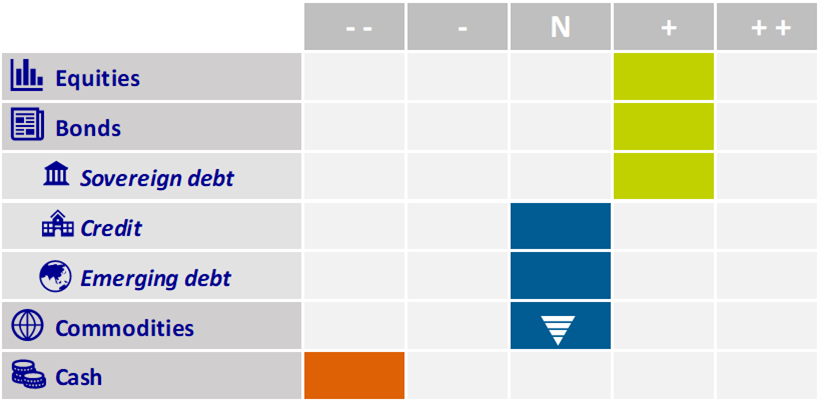
Multi-Asset Investments Views: Hold the line, disinflation isn’t always on time
- 30 April 2024 (7 min read)
KEY POINTS

Our views
April sent financial markets back to the painfully positive correlation of last summer: interest rates rose, depreciating the value of bonds, whilst equities also corrected, offering few places to hide in multi-asset portfolios (although our allocation to commodities was helpful).
Indeed, repeatedly strong prints on US inflation put in question, again, the market narrative that the Federal Reserve (Fed) has finished with monetary tightening and is therefore preparing to cut interest rates in the foreseeable future. As we expressed in previous editions, our positive outlook for risky assets (especially equities) is not predicated on a specific starting date for Fed policy rate cuts but rather on the subsequent path and landing destination for policy.
Similarly, whether we see two or three cuts this year is not material for the equity rally to find another leg higher. Instead, the crucial question in our view is whether we will see any cuts at all. As illustrated in the chart below, the valuation of equities is therefore more closely linked to the volatility in interest rates (similar to the uncertainty around the future trajectory in interest rates) more than to the absolute level of interest rates.
We are mindful of further market volatility in the near term, with fear gaining momentum and with investor positioning having reached elevated levels. Beyond this market wobble, we remain confident that, on balance, monetary tightening is over. Financial conditions have already significantly tightened and were transmitted to private agents (households and small- and medium-sized companies), primarily through bank lending. Although cash-rich, low-debt tech large corporations benefit from unprecedentedly high short-term interest rates on their large savings, small firms and middle-class Americans are not as immune to monetary tightening. Indeed, the US Small Business Optimism Index decreased in March to its lowest level since December 2012 and our own US Credit Research analysts see some signs of stress in the most vulnerable parts of the US economy.
As market participants regain confidence in rate cuts, regardless of the timing, this should translate into lower interest rate volatility, offering additional support for equities. Furthermore, our anticipated expansion in the breadth of equity market performance has begun to materialise which further supports our positive stance.
Meanwhile, the economic situation is quite different in Europe, further amplifying the transatlantic divergence. Disinflation is still on track (with Eurozone headline inflation down to +2.4% in March) and economic activity is more hesitant (growth stalling last quarter). More importantly and in stark divergence from the US, fiscal policy is heading into contraction territory, even though unemployment is rising marginally in large member states (albeit from a cyclical low a year ago).
This explains the much more prudent European Central Bank communication and confirms our expectation of monetary policy loosening by summer. Of course, long-dated euro interest rates suffered in sympathy with US Treasury yields, which we see as adding a valuation argument to the macro one for this trade.
Altogether, our portfolios remain overweight equities, viewing the recent pullback as almost over and not a change of paradigm. We may even consider adding risk later on, if and when we get a downturn in interest rate volatility. Within equities, we maintain our preference for quality but are preparing to add more cyclicality. We also hold on to our duration through Eurozone sovereign debt, whilst we patiently wait to expand into US duration, favouring the front-end of the curve for now (two-year). While significant moves in oil, industrial metals and gold prices now factoring in at least some of the Middle Eastern tensions and early signs of recovery of the Chinese economy, the parallel spike in long positioning prompted us to exit our overweight in commodities.
Equity valuations move in tandem with interest rate volatility

Source: IBES, Bloomberg
Disclaimer
The information on this website is intended for investors domiciled in Switzerland.
AXA Investment Managers Switzerland Ltd (AXA IM) is not liable for unauthorised use of the website.
This website is for advertising and informational purpose only. The published information and expression of opinions are provided for personal use only. The information, data, figures, opinions, statements, analyses, forecasts, simulations, concepts and other data provided by AXA IM in this document are based on our knowledge and experience at the time of preparation and are subject to change without notice.
AXA IM excludes any warranty (explicit or implicit) for the accuracy, completeness and up-to-dateness of the published information and expressions of opinion. In particular, AXA IM is not obliged to remove information that is no longer up to date or to expressly mark it a such. To the extent that the data contained in this document originates from third parties, AXA IM is not responsible for the accuracy, completeness, up-to-dateness and appropriateness of such data, even if only such data is used that is deemed to be reliable.
The information on the website of AXA IM does not constitute a decision aid for economic, legal, tax or other advisory questions, nor may investment or other decisions be made solely on the basis of this information. Before any investment decision is made, detailed advice should be obtained that is geared to the client's situation.
Past performance or returns are neither a guarantee nor an indicator of the future performance or investment returns. The value and return on an investment is not guaranteed. It can rise and fall and investors may even incur a total loss.
AXA Investment Managers Switzerland Ltd.